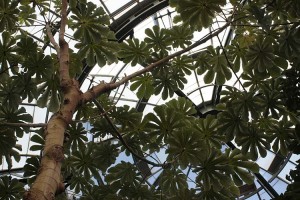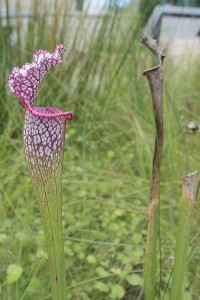I loved this banner at the Huntington. Hanging outside the instution’s conservatory building, it announces that the exhibits inside might be more oriented towards education than the gardens that make up the rest of the grounds. The conservatory also houses plants that might have special needs beyond the “just add water” plantings located in the subtropics outdoors.
Pass through the front doors and you step into a greenhouse space containing a miniature tropical rainforest, a cloud forest and a bog garden, along with lots of educational signs and interactive exhibits scattered throughout the space.
For me most greenhouses and conservatory gardens suffer from being examples of nature-in-a-can, and to me they tend to look and smell and feel very similar in their hermetically sealed spaces. If only the Huntington were located on some barren snowy tundra plain, where entering a tropical rainforest on a cold winter day might be a stunning revelation.
Even on this cool December Southern California afternoon, the temperature differences between inside and out weren’t that pronounced. And the lush plantings outside the front door seemed to mirror the lushly planted indoors. Still, lacking the stunning contrasts that might help to set the conservatory apart from the outdoors, it was a fun place to connect with a lot of cool plants. When the Huntington’s giant corpse-flower (Amorphophallus titanum) blooms, there is where you’ll find it. It wasn’t blooming, but there were lots of other interesting things inside.
The bright red-orange trunks of the sealing-wax palm, Cyrtosstachys renda were pretty amazing.
My visit was two days before Christmas, so there were this holiday display of poinsettias and amaryllis. At first they seemed like gratuitous holiday decorations but then the aha moment struck me that these plants originate in the tropical and subtropical belt of the Americas.
Floral parts of a large anthurium species…
This carnivorous Asian pitcher plant (a species of Nepenthes) greeted visitors as they entered the cloud forest display.
And dropping down into the bog garden, American pitcher plants, Sarracenia, and sundews, Drosera sp., let viewers see other ways plants have taken up carnivorous ways. (Do you detect a theme of the conservatory playing up the idea of scary, creepy plants, going from these carnivorous species to the stinking giant corpse flower that lines up visitors by the hundreds when it does its thing?)
At this point the blogger rambles on a bit: These days it almost seems that every botanical collection feels to have its very own giant corpse flower plant that will draw the visitors when it blooms, something of the way medieval churches tried to draw pilgrims by having unique relics of saints, or how many temples in Asia will claim to have preserved hairs of the Buddha. So it seems that the giant corpse flowers has become a modern secular botanical relic. It’s a little odd, since you can occasionally find the plant for sale on eBay–granted for a good chunk of change–but still nothing much more than you’d pay for a pair of high-end jeans.
Okay, now back to the trip…
I’m coming to the realization that greenhouses always scare me a bit, like I’m entering a world that’s on perpetual life support. Upon leaving the conservatory I stepped outside into the bright December afternoon. Not far away a reader was seated in warming sunlight on a Lutyens bench, enjoying the moment. I’d had a good time on my visit to the synthetic tropics, but returning to the real sunshine and real weather outdoors I suddenly felt free.










It is a treat to come to your blog and visit these lovely garden on this very cold winter day.
We missed this part of the Huntington on our visit as we ran out of time. I’ve never really thought about it but I think you’ve hit on something with your green house observation.
I share your feelings about greenhouses. They creep me out. I think your analogy of being inside a life support system rings true.
There was a big fuss amongst the master gardener crowd here two years ago when someone’s (I forget whose) corpse flower was about to bloom. Turned out to be a big let down – not much of a smell at all.
Must admit, I didn’t know they were ubiquitous til I read your post.
The Huntington is now an absolute “must-see” for me, James. With a daughter now living there, I can see bothering you for a joint visit in the future. I mean, judging from your descriptions, it sounds almost “Smithsonian-like” with all the different sty;es and areas of the place. As if one could spend days and still not catch it all.
I can totally understand your feeling of freeness outside. Tropical gardens do seem ‘canned’ but ever so welcomed on a cold winter day. It was all the thing for my family to do when we lived in Germany during the winter and walking inside a hothouse was like day and night and most welcomed. The humidity itself was something else too. I’ve never seen a corpse flower though, I bet they are cool.
I really enjoyed your perspective on the indoor rainforest, James. We used to live near there, in Fullerton and never visited the Huntington, although the beach was visited regularly. Lacking the cold to warm that is experienced in arboretums where the winter is quite cold is much more of a trip. What could they do to make it more special to discerning visitors like you, she wonders. 🙂
Frances
Interesting thoughts there. I have never thought of life support for plants while inside the steamy buildings but now you have my mind going. And yes, you are so correct as they are living with a human life support! I dont think I would care to be on life support but I would like to have a perfect climate to enjoy year round!
Thanks for all your comments! I should do some full disclosure here: I do have a small back yard greenhouse, and in the late 80s and 90s I maintained it as a hothouse to grow tropical lowland orchids. Even for a small little greenhouse, it was a resource-intense and fairly expensive proposition, not to mention a lot of work. These days it’s unheated and mainly used for propagating seedlings and for the few remaining orchids that refuse to die. I grew up in the tropics and I’ll admit to having enjoyed stepping inside the greenhouse and breathing in the warm, humid air. But as I try to practice gardening that’s less resource-intensive and closer to the land, my backyard greenhouse’s days are looking like they’re numbered. So…greenhouses do have a place in the garden world, for sure, but they’re definitely not a tool that will help you make peace with your own land or climate.
And a few specific responses: Susan, the corpse flower is supposed to have just a few hours of maximum stink-time. If you miss it, it’s maybe no worse than old laundry…
Steve, the Huntington is just one of three really worthwhile garden destinations in that part of LA County. Look me up if you’re headed to town to visit your daughter!
Tina, I think you got a chance with the German conservatory to experience the most contrast between inside and out. If it makes a population of kids more interested in protecting all the world’s plant life, then they’ve begun to do some good.
Frances, too bad you didn’t make it to the Huntington! In my teens I lived just over the county line from Fullerton, and dragged my family there when I could. I’m still not sure what could make a conservatory greenhouse really distinctive, either. But maybe some amazing designer will come along and do a conservatory that really rocks.
Skeeter, all this thinking is starting to look like another post. Isn’t all gardening to some extent dealing with plants that might not be able to thrive without human intervention where we plant them? A greenhouse just amplifies that.
I like to think that folks actually go to see the giant flower, more than the corpsey-fresh scent.
Greg, I’m sure the giant flower thing is high on the list as well. How do you turn down the world’s largest flower, even if it smells like spoiled hamburger?